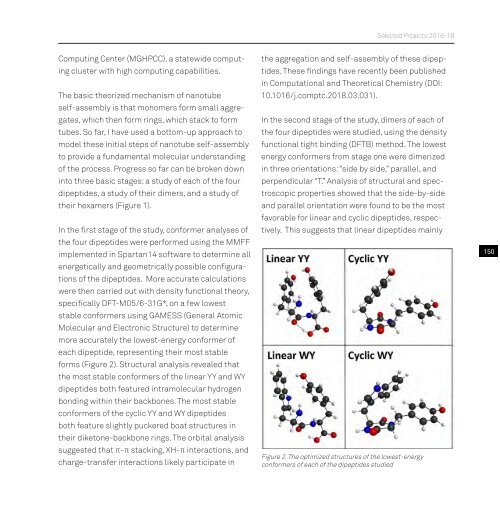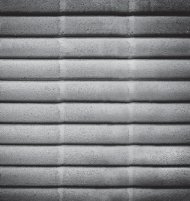Undergrad_Book_16-18_Pge_View_Print_no print marks_compressed
Create successful ePaper yourself
Turn your PDF publications into a flip-book with our unique Google optimized e-Paper software.
Selected Projects 20<strong>16</strong>-<strong>18</strong><br />
Computing Center (MGHPCC), a statewide computing<br />
cluster with high computing capabilities.<br />
The basic theorized mechanism of na<strong>no</strong>tube<br />
self-assembly is that mo<strong>no</strong>mers form small aggregates,<br />
which then form rings, which stack to form<br />
tubes. So far, I have used a bottom-up approach to<br />
model these initial steps of na<strong>no</strong>tube self-assembly<br />
to provide a fundamental molecular understanding<br />
of the process. Progress so far can be broken down<br />
into three basic stages: a study of each of the four<br />
dipeptides, a study of their dimers, and a study of<br />
their hexamers (Figure 1).<br />
In the first stage of the study, conformer analyses of<br />
the four dipeptides were performed using the MMFF<br />
implemented in Spartan14 software to determine all<br />
energetically and geometrically possible configurations<br />
of the dipeptides. More accurate calculations<br />
were then carried out with density functional theory,<br />
specifically DFT-M05/6-31G*, on a few lowest<br />
stable conformers using GAMESS (General Atomic<br />
Molecular and Electronic Structure) to determine<br />
more accurately the lowest-energy conformer of<br />
each dipeptide, representing their most stable<br />
forms (Figure 2). Structural analysis revealed that<br />
the most stable conformers of the linear YY and WY<br />
dipeptides both featured intramolecular hydrogen<br />
bonding within their backbones. The most stable<br />
conformers of the cyclic YY and WY dipeptides<br />
both feature slightly puckered boat structures in<br />
their diketone-backbone rings. The orbital analysis<br />
suggested that π-π stacking, XH-π interactions, and<br />
charge-transfer interactions likely participate in<br />
the aggregation and self-assembly of these dipeptides.<br />
These findings have recently been published<br />
in Computational and Theoretical Chemistry (DOI:<br />
10.10<strong>16</strong>/j.comptc.20<strong>18</strong>.03.031).<br />
In the second stage of the study, dimers of each of<br />
the four dipeptides were studied, using the density<br />
functional tight binding (DFTB) method. The lowest<br />
energy conformers from stage one were dimerized<br />
in three orientations: “side by side,” parallel, and<br />
perpendicular “T.” Analysis of structural and spectroscopic<br />
properties showed that the side-by-side<br />
and parallel orientation were found to be the most<br />
favorable for linear and cyclic dipeptides, respectively.<br />
This suggests that linear dipeptides mainly<br />
Figure 2. The optimized structures of the lowest-energy<br />
conformers of each of the dipeptides studied<br />
150



